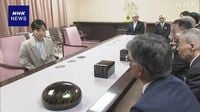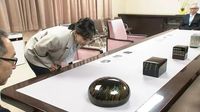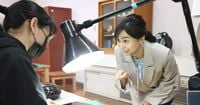On April 17, 2025, Princess Kako of the Akishino family visited the Ishikawa Prefectural Wajima Lacquer Art Technical Training Institute in Wajima City, Ishikawa Prefecture. This visit was particularly significant as it came after the devastating Noto Peninsula Earthquake, which had a profound impact on local lacquerware craftsmen.
As the President of the Japan Crafts Council, Princess Kako has been actively involved in supporting the arts and crafts community in Japan. During her visit, she interacted with local lacquerware artists who had been affected by the earthquake and were currently working in temporary workshops. "How are you doing in this difficult environment?" she asked, showing genuine concern for their well-being.
Princess Kako toured the training institute, which had previously been forced to suspend classes due to the earthquake. Fortunately, the institute resumed its courses in October 2024 after a nine-month hiatus. The facility teaches various techniques, including lacquer painting, Chinkin, and Maki-e, and is staffed by some of Japan's most esteemed lacquerware artisans.
During her visit, Princess Kako observed a classroom where students were learning the intricate 'Chinkin' decorative technique. She engaged with the trainees, asking, "What do you focus on when creating your pieces?" Her interest in their work and dedication to the craft was evident as she carefully examined their creations.
Not only did Princess Kako ask questions, but she also took part in the Chinkin process herself. She applied lacquer to a board and embedded gold powder, all while receiving guidance from the instructors. "This is difficult," she remarked with a smile, embodying the spirit of learning and appreciation for the craft.
One of the highlights of the visit was her conversation with Katsutoshi Ukide, a 70-year-old lacquer artist and lecturer at the training institute. Ukide shared a piece he created, which depicted lavender blooming in his garden—a poignant reminder of beauty amidst the devastation, as his home was completely destroyed in the earthquake. Princess Kako expressed her admiration, saying, "It feels like I can smell the fragrance."
Princess Kako's visit was initially planned for October of the previous year but had to be postponed due to record-breaking rainfall that struck the Noto region. The rescheduling allowed her to connect with the artists at a time when they truly needed support and encouragement.
The Noto Peninsula Earthquake, which struck in January 2024, caused significant damage to the region, affecting many local artisans who rely on traditional techniques passed down through generations. The earthquake's aftermath left many craftsmen in precarious situations, working from temporary setups while trying to maintain their art.
Through her visit, Princess Kako not only provided moral support to the lacquerware artists but also highlighted the importance of preserving traditional crafts in Japan. Her engagement with the craftsmen and the training institute underscores her commitment to cultural heritage and the arts.
As the President of the Japan Crafts Council, Princess Kako plays a vital role in advocating for artisans and ensuring that traditional crafts continue to thrive even in challenging times. Her presence at the Wajima Lacquer Art Technical Training Institute serves as a reminder of the resilience of the human spirit and the importance of community support in the face of adversity.
The visit was covered by various media outlets, emphasizing the significance of Princess Kako's involvement in the arts and her dedication to helping those affected by the earthquake. Her actions resonate beyond the immediate support, inspiring a renewed interest in traditional crafts among the younger generation.
In a world where modern technology often overshadows traditional skills, Princess Kako's visit serves as a beacon of hope for the preservation of cultural heritage. It encourages not only the artists in Wajima but also others across Japan to continue their work, innovate, and share their crafts with future generations.
As the community continues to rebuild and recover from the earthquake, the support from figures like Princess Kako plays an essential role in fostering a sense of hope and resilience among the artisans. Her visit is a testament to the enduring spirit of craftsmanship and the importance of cultural identity in Japan.








